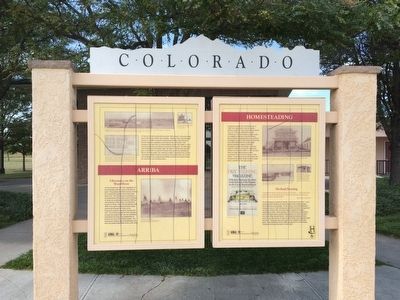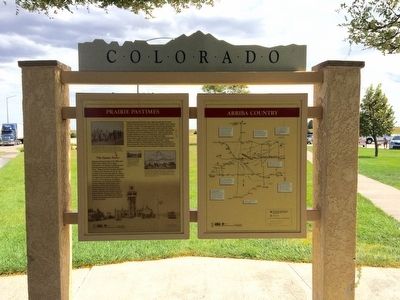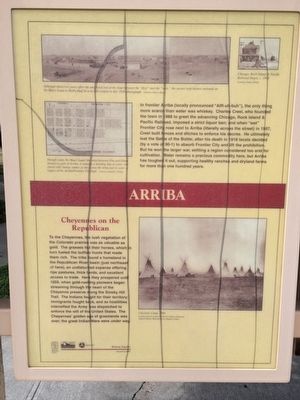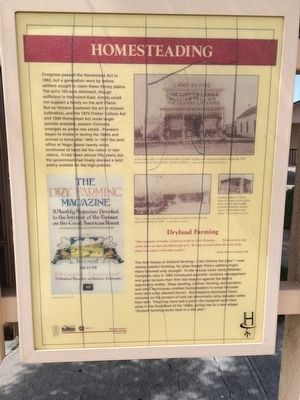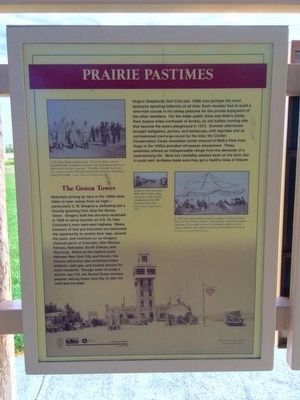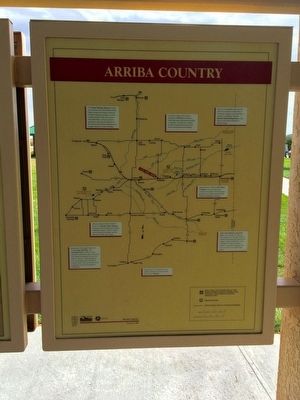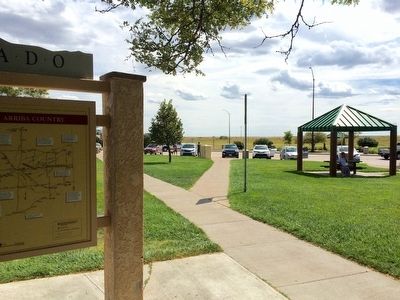Arriba in Lincoln County, Colorado — The American Mountains (Southwest)
Arriba Country
Colorado
Panel 1
In frontier Arriba (locally pronounced "AIR-uh-buh"), the only thing more scarce than water was whiskey. Charles Creel, who founded the town in 1888 to greet the advancing Chicago, Rock Island & Pacific Railroad, imposed a strict liquor ban; and when "wet" Frontier City rose next to Arriba (literally across the street) in 1907 Creel built fences and ditches to enforce his decree. He ultimately lost the Battle of the Bottle; after his death in 1918 locals decided (by a vote of 90-1) to absorb Frontier city and lift the prohibition. But he won the larger war, settling a region considered too arid for cultivation. Water remains a precious commodity here, but Arriba has toughed it out, supporting healthy ranches and dryland farms for more than one hundred years.
Cheyennes on the Republican
To the Cheyennes, the lush vegetation of the Colorado prairies was as valuable as gold. The grasses fed their horses, which in turn fueled the buffalo hunts that made them rich. The tribe found a homeland in the Republican River basin (just northeast of here), an undisturbed expanse offering ripe pastures, thick herds, and excellent access to trade. Here they prospered until 1859, when gold-rustling pioneers began streaming through the heart of the Cheyenne preserve along the Smoky Hill Trail. The Indians fought for their territory immigrants fought back, and as hostilities intensified the Army was dispatched to enforce the will of the United States. The Cheyennes' golden age of grasslands was over; the great Indian Wars were under way.
Top large photo:
Although taken two years after the unofficial end of the feud between the “drys” and the “wets,” the vacant strip known variously as No Manís Land or Hellís Half Acre is still evident in this 1920 photograph. Courtesy Eunice Burge
Top right small photo:
Chicago Rock Island & Pacific Railroad Depot c. 1916
Courtesy Eunice Burge
Middle photo:
Though today No Manís Land (the strip between Elm And Grant streets) is part of Arriba, it remains a dividing line of sorts – the streets still change names as they cross the strip east to west – a legacy of the Arriba/Frontier City feud. Courtesy Eunice Burge
Bottom photo:
Cheyenne Camp, 1868
Courtesy Seaver Center for Western History Research, Natural History Museum of Los Angeles County
Panel 2
Congress passed the Homestead Act in 1862, but a generation went by before settlers sought to claim these thirsty plains. The act's 160-acre allotment, though sufficient in the humid East, simply could not support a family on the arid Plains. But as farmers mastered the art of dryland cultivation, and the 1872 Timber Culture Act and 1909 Homestead Act made larger parcels available, eastern Colorado emerged as prime real estate Pioneers began to trickle in during the 1890s and arrived in force after 1900; in 1907 the land office at Hugo (about twenty miles southwest of here) led the nation in new claims. It had taken almost fifty years, but the government had finally devised a land policy suitable for the high prairies.
Dryland Farming
The first theory of dryland farming—“rain follows the plow”— was merely wishful thinking; for plow though Plains settlers might, there followed only drought. To the rescue came Hardy Webster Campbell, who in 1902 introduced scientific moisture management and gave farmers their first real weapon against the Westís oppressive aridity. Deep seeding, contour farming, soil aeration and other techniques enabled homesteaders to wrest harvests from land once deemed barren. But skeptics dismissed these victories as the product of luck (an abnormally rainy decade) rather then skill. They may have had a point; the marginal soils blew away in the Dust Bowl of the 1930s, giving rise to a new adage: "Dryland farming works best in a wet year.”
Top large photo:
A real estate office in neighboring Hugo proudly displays non-irrigated produce during the 1907 Lincoln County Fair and Dry Farmers Jubilee. Courtesy Lincoln County Historical Society
Middle left:
Cover of "Dry Farming Magazine"
Colorado Historical Society
Small middle photo:
Once a part of the Dust Bowl, this farm northwest of Arriba was again prospering by 1950. Colorado Historical Society
Smaller right photo:
Lacking lumber or brick, Lincoln County settlers often built with the only readily available material -- prairie sod, as in this house near Limon.Colorado Historical Society
Panel 3
Hugo's Shepherds Golf Club (est. 1898) was perhaps the most exclusive sporting fraternity of all time: Each member had to build a nine-hole course in his sheep pastures for the private enjoyment of the other members. For the wider public there was Walk's Camp Park (twelve miles northwest of Arriba), an old buffalo hunting site that became the area's playground in 1915. Summer afternoons brought ballgames, picnics, and barbecues, with hayrides and an merry-go-round for the kids; the Civilian Conservation Corps recreation center (moved to Walk's Park from Hugo in the 1940s) provided off-season amusement. These amenities offered an indispensable refuge from the demands of a hard-working life. More toil inevitably awaited back on the farm, but it could wait; Arribans made sure they got a healthy dose of leisure.
Genoa Tower
Motorists driving by here in the 1930s liable to hear voices from on high --- particularly C. W. Gregory's, bellowing out a friendly greeting from atop the Genoa Tower. Gregory built the six-story landmark in 1926 to serve tourists on U.S. 24, then Colorado's main east-west highway. Weary the opportunity to stretch their legs, ascend the spire, and overlook (or so Gregory claimed) parts of Colorado, New Mexico, Kansas, Nebraska, South Dakota Wyoming. Billed as the highest point between New York City and Denver, the famous attraction also exhibited Indian artifacts, sold gas, and hosted dances for local residents. Though most of today's drivers use I-70, the Genoa Tower remains popular among those who like to take the road less traveled.
Top left photo
As the Hugo Range Ledger noted, "Cheyenne Wells, with its delightful band, is entitled to a hearty vote of thanks for the way it helped make the fair a success." The Hugo baseball team was also a success at the 1907 fair, beating all opponents, including a team from Arriba. Courtesy Lincoln County Historical Society
Small middle photo:
Members of the Cheyenne Wells Silver Cornet Band engage in a little friendly competition at the 1907 Lincoln County Fair.
Courtesy Lincoln County Historical Society
Far right photo:
In 1907 area businessmen decided to organize a Lincoln County Fair and Dry Farmers Jubilee. Held in Hugo, activities included ball games, horse and foot races, watermelon eating contests, singers, dancers, and rides on a horse-powered merry-go-round.
Courtesy Lincoln County Historical Society
Bottom large photo:
Genoa Tower, late 1930s
Colorado Historical Society
Panel 4
Erected 2001 by the Colorado Historical Society, Colorado Department of Transportation. (Marker Number 245.)
Topics and series. This historical marker is listed in these topic lists: Agriculture • Native Americans • Railroads & Streetcars • Roads & Vehicles. In addition, it is included in the Chicago Rock Island & Pacific Railway, and the Colorado - History Colorado series lists. A significant historical year for this entry is 1888.
Location. 39° 16.857′ N, 103° 16.255′ W. Marker is in Arriba, Colorado, in Lincoln County. Marker can be reached from the intersection of County Road 63 and Interstate 70. Located in the Colorado Department of Transportation Rest Area in Arriba at I-70 exit 383. Touch for map. Marker is in this post office area: Arriba CO 80804, United States of America. Touch for directions.
Other nearby markers. At least 4 other markers are within 15 miles of this marker, measured as the crow flies. Welcome to Lincoln County (approx. 14.6 miles away); Hugo Country (approx. 14.6 miles away); Hugo Municipal Pool (approx. 14.6 miles away); Lincoln County World War I Memorial (approx. 14.7 miles away).
Also see . . . History of Arriba - How Arriba Came to Be. (Submitted on October 7, 2015, by Mark Hilton of Montgomery, Alabama.)
Credits. This page was last revised on July 26, 2016. It was originally submitted on October 7, 2015, by Mark Hilton of Montgomery, Alabama. This page has been viewed 800 times since then and 32 times this year. Photos: 1, 2, 3, 4, 5, 6, 7. submitted on October 7, 2015, by Mark Hilton of Montgomery, Alabama.
